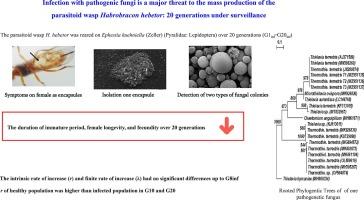Infection with pathogenic fungi is a major threat to the mass production of the parasitoid wasp Habrobracon hebetor: 20 generations under surveillance
IF 3.7
2区 农林科学
Q2 BIOTECHNOLOGY & APPLIED MICROBIOLOGY
引用次数: 0
Abstract
Pathogen infection is one of the most important challenges threatening the success of mass rearing of natural enemies either in insectaries or in augmentative biological control programs. In this investigation, we studied the biological and population growth parameters of a naturally infected colony of the parasitoid wasp Habrobracon hebetor (Say) (Hymenoptera: Braconidae) over 20 generations (G1inf − G20inf) of rearing on Ephestia kuehniella (Zeller) (Pyralidae: Lepidoptera) under laboratory conditions. Based on morphological characteristics and ITS sequences, two types of fungal colonies were isolated from the diseased females and identified as Thermothielavioides terrestris and Aspergillus flavus. The results showed that although no significant differences were found in the female longevity and fecundity of H. hebetor on E. kuehniella up to G15inf, the duration of the immature period was extended as the number of generations increased. In addition, the intrinsic rate of increase (r) and finite rate of increase (λ) had no significant differences up to G8inf. The net reproductive rate (R0) of G15inf had no significant differences with G2inf, G8inf, and G10inf. On the other hand, in G15inf, R0 was significantly higher than G4inf, G6inf, and G20inf. The findings underscore the negative impact of fungal infection on population growth parameters compared with uninfected population. This study showed that naturally fungal infection of the parasitoid affected the population growth and life table parameters through mass rearing, compared and discussed with the healthy parasitoid.

感染病原真菌是寄生蜂 Habrobracon hebetor 大量繁殖的主要威胁:20 代的监测情况
病原体感染是威胁昆虫饲养场或辅助生物防治计划中天敌大规模饲养成功的最重要挑战之一。在这项调查中,我们研究了寄生蜂 Habrobracon hebetor (Say) (膜翅目:喙蜂科)在实验室条件下饲养 Ephestia kuehniella (Zeller) (鳞翅目: Pyralidae)20 代(G1inf - G20inf)过程中自然感染蜂群的生物和种群增长参数。根据形态特征和 ITS 序列,从患病雌虫体内分离出两种类型的真菌菌落,分别鉴定为赤霉病菌(Thermothielavioides terrestris)和黄曲霉菌(Aspergillus flavus)。结果表明,虽然 H. hebetor 对 E. kuehniella 的雌虫寿命和繁殖力在 G15inf 之前没有明显差异,但随着世代数的增加,未成熟期的持续时间延长。此外,内在增长率(r)和有限增长率(λ)在 G8inf 之前没有显著差异。G15inf 的净生殖率(R0)与 G2inf、G8inf 和 G10inf 没有显著差异。另一方面,G15inf 的 R0 显著高于 G4inf、G6inf 和 G20inf。与未感染的种群相比,这些发现强调了真菌感染对种群生长参数的负面影响。本研究表明,通过大量饲养,寄生虫自然感染真菌会影响种群的生长和生命表参数,并与健康寄生虫进行了比较和讨论。
本文章由计算机程序翻译,如有差异,请以英文原文为准。
求助全文
约1分钟内获得全文
求助全文
来源期刊

Biological Control
生物-昆虫学
CiteScore
7.40
自引率
7.10%
发文量
220
审稿时长
63 days
期刊介绍:
Biological control is an environmentally sound and effective means of reducing or mitigating pests and pest effects through the use of natural enemies. The aim of Biological Control is to promote this science and technology through publication of original research articles and reviews of research and theory. The journal devotes a section to reports on biotechnologies dealing with the elucidation and use of genes or gene products for the enhancement of biological control agents.
The journal encompasses biological control of viral, microbial, nematode, insect, mite, weed, and vertebrate pests in agriculture, aquatic, forest, natural resource, stored product, and urban environments. Biological control of arthropod pests of human and domestic animals is also included. Ecological, molecular, and biotechnological approaches to the understanding of biological control are welcome.
 求助内容:
求助内容: 应助结果提醒方式:
应助结果提醒方式:


